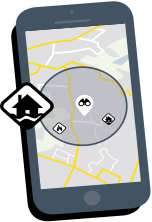Consider the risks and make a plan
Planning and preparing for emergencies at home can help protect your family and property, reduce the impact of the emergency, and recover quicker after.
Taking the time to think about emergencies and making a plan helps you to think clearly, have a greater sense of control, and make better decisions when an emergency occurs.
Emergencies can happen anywhere, at any time. It’s important to have a plan, know what to do and where to find information in an emergency.
Considering the risks in an emergency at home can include:
-
using your local flood guide,
-
how to 'bag it, block it, lift it and leave', and what steps to take as an emergency takes place.
For members of our community with additional needs:
-
People with Developmental/Cognitive/Intellectual Disabilities: If you have difficulty understanding, remembering, or learning, keep a simple list of what to do and important information with you and in your emergency kits. Practice your plan in advance. If you use augmentative communication supports, include these in your planning.
-
People who are deaf or hard of hearing: Prior to a flood, storm, earthquake or other emergencies, identify and test multiple ways to receive warnings and evacuation information.
-
People who are blind or have low vision: Earthquakes and storm events can cause items to fall and furniture to shift. Regular sound clues may not be available afterwards. Move with caution.
There are simple and practical steps you can take to protect yourself, the people you love, and the things you value most. Create an emergency plan:
How to use sandbags to protect your home from flooding
There are a few things you can do to ensure that you, and your property, stay safe during a flooding event.
Sandbags will not stop water completely, but they can reduce the amount of water entering your home. During low-level flooding, sandbags placed in the right locations around your home can reduce the impact of flooding.
- Review the VICSES sandbag quick reference guide
Watching the video below will show you how to sandbag your home, to help reduce the impact of floods. It explains the different types; when to use them; how to fill them; lay them safely, and dispose of them afterward.
If your home is close to a river; creek; major storm drain, or in a low-lying area then you may be at greater risk of flood impact. Get to know your area by understanding your local flood guide - find yours.







